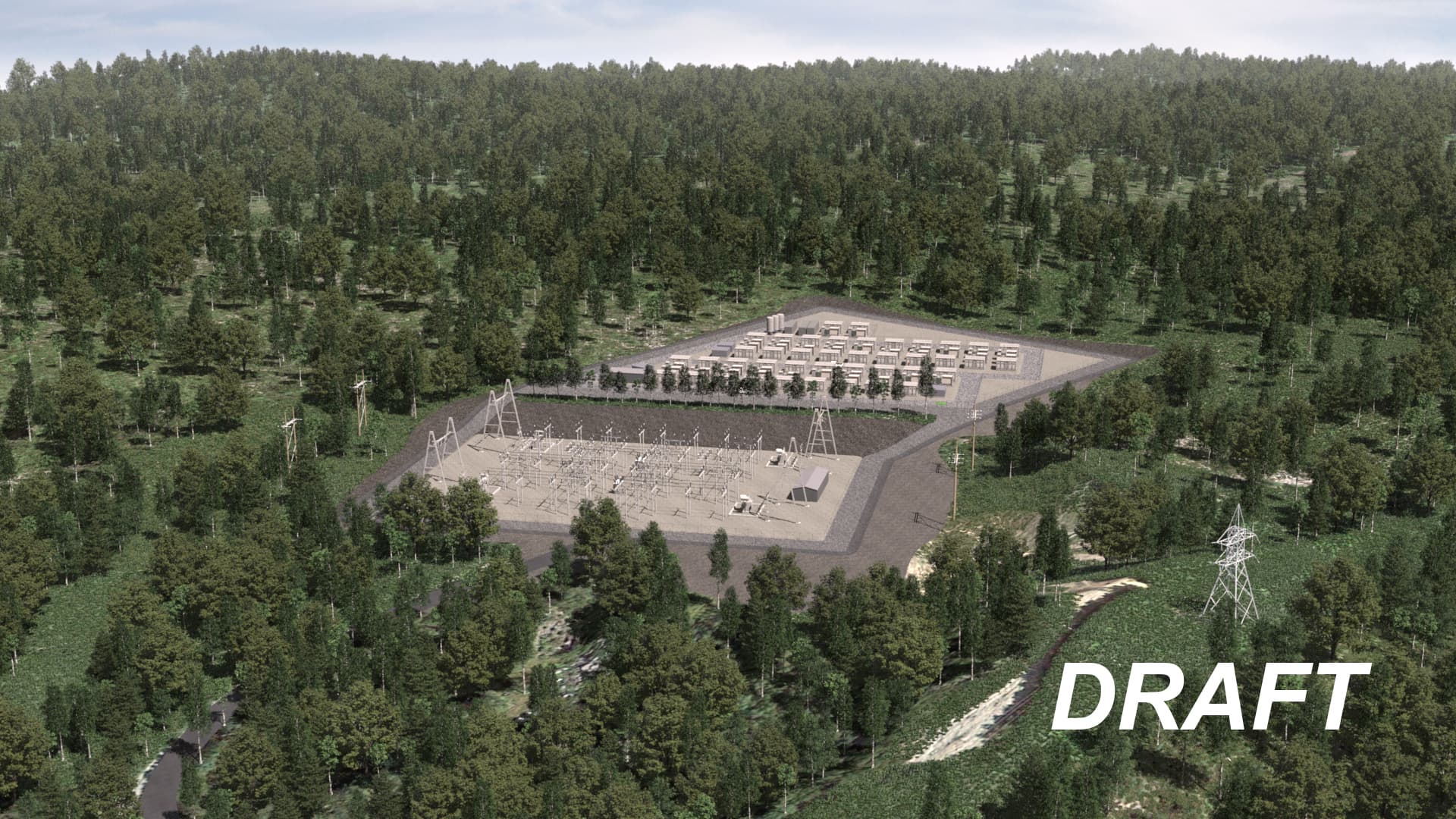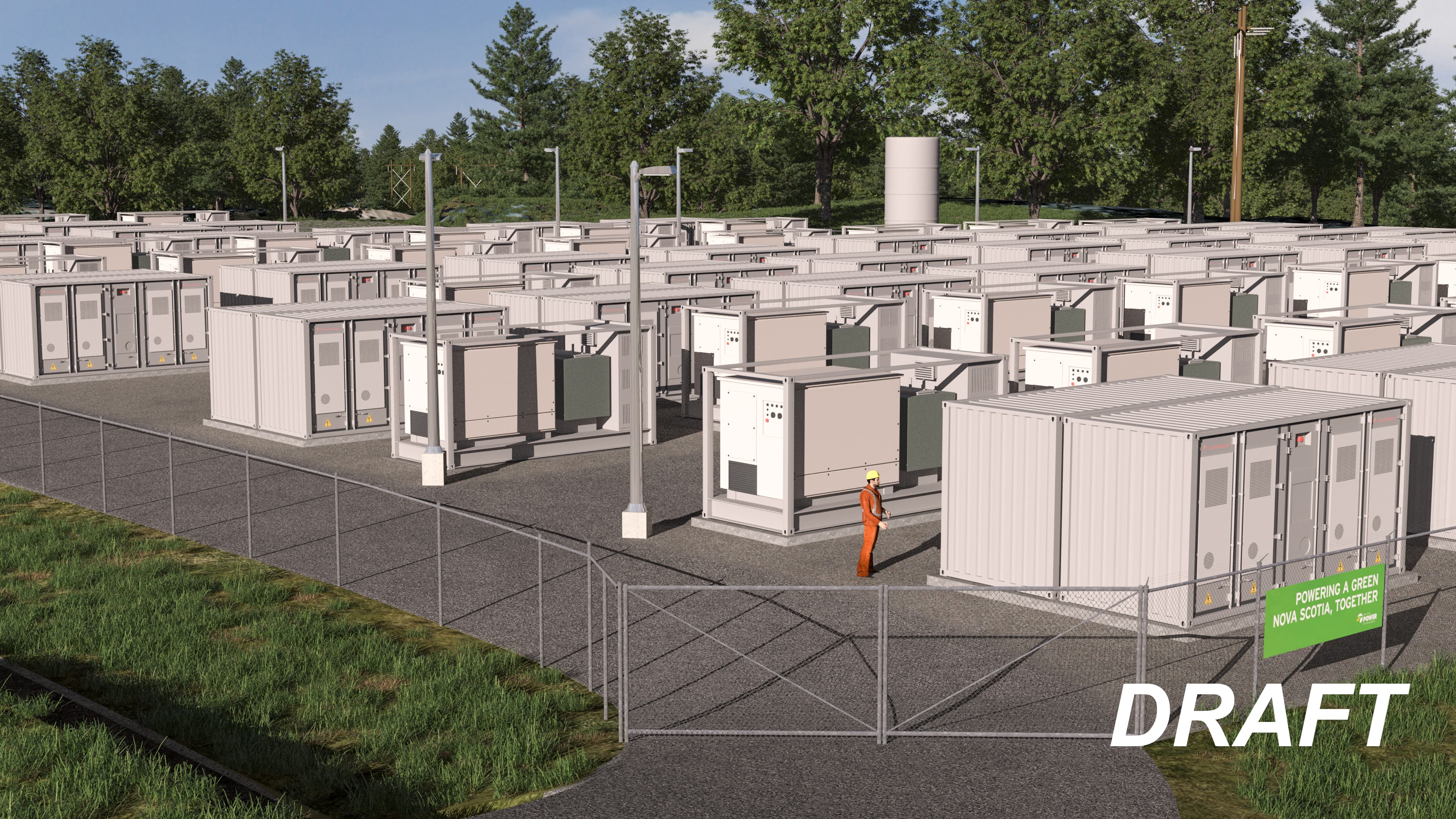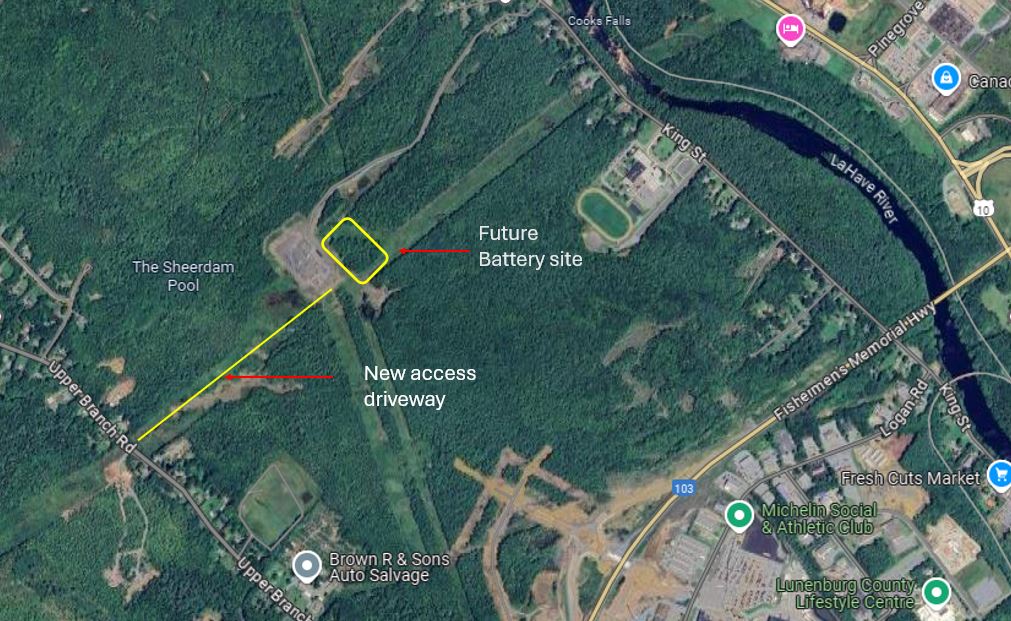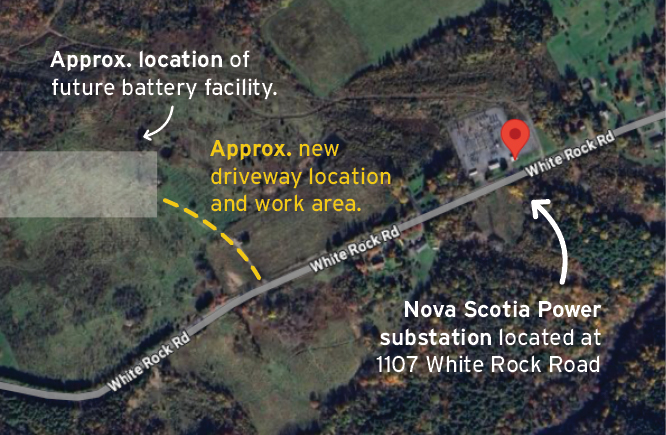For the size and capacity of our proposed energy storage facilities, the lowest cost commercially available technology is lithium-ion batteries.
Grid-Scale Batteries
Grid-Scale Batteries
We are developing three 50 MW 4-hour grid-scale battery facilities in Bridgewater, the Valley, and Waverley. These facilities will enhance reliability for our customers as the province expands wind capacity and explores opportunities for hydrogen, making sure reliable and safe power is there when our customers need it.
Our project team has been working with stakeholders and engaging communities throughout the planning stages of the development. In June 2024, we received full project approval from the Nova Scotia Utility and Review Board for the capital costs required to develop the grid-scale battery facilities.
Preliminary site work has begun and will continue through 2026, with the first site operational in 2025.
The Grid-Scale Battery project aligns with the Province’s Clean Power Plan. In December 2023, the Department of Natural Resources and Renewables provided an Order in Council, directing Nova Scotia Power to build three grid-scale battery facilities.
How Grid-Scale Batteries Work
The grid-scale battery facilities have various functions that will benefit the grid throughout the clean energy transition and beyond. These benefits include:
- Fast response to unplanned grid disturbances
- Safe, reliable, and clean energy during peak demand
- Opportunity to introduce and enable more renewable energy
Here are some generic renderings of a typical grid-scale battery facility. The layout of containers may differ in the future constructed project.


Working with Partners
This project represents the many ways we’re collaborating with partners to help mitigate costs for customers and work meaningfully with all 13 Mi’kmaw communities.

Together, the Wskijnu’k Mtmo’taqnuow Agency and Nova Scotia Power have shaped an investment arrangement that enables Mi’kmaw communities to participate as equity partners in relation to the grid-scale battery project, benefitting all 13 Mi’kmaw communities in Nova Scotia.

The Grid-Scale Battery project is the first clean energy project part of the Canada Infrastructure Bank’s Indigenous Equity Initiative. Through secured low-cost financing, this collaboration is helping to mitigate costs for customers.

Through Natural Resources Canada’s Smart Renewable and Electrification Pathways Program (SREP) and the Electricity Predevelopment Program (EPP), over $117 million has been secured for the project, representing roughly one third of the total project cost.
Community and Stakeholder Engagement
We are committed to being the first and best source of information for community members and stakeholders about our battery projects. Community and stakeholder engagement started early in our planning stages and is continuing throughout the development and implementation of the sites.
To date, our project team has engaged with key stakeholders and hosted community open houses in each of the three communities we’re working in. Identified communities and stakeholders include:
- Mayors, MLAs, and MPs from each community
- Residents living near battery sites
- Local community
- Local businesses
- Local fire stations
- Environmental groups
Are we missing a community group or stakeholder that you think should be on the list? Email us at engage@nspower.ca with your suggestion.
What We're Hearing from You
"Anything that gets Nova Scotia off fossil fuel is a beautiful thing!"
White Rock Customer
"The first major concern is the sourcing of materials, like lithium. My concerns are environmental, the ethical treatment of communities and people, and proper pricing."
Bridgewater Customer
"This is a really neat project! Once they're built, there should be public tours."
Spider Lake Customer
Facilities

Bridgewater Grid-Scale Battery Facility
Our grid-scale battery site will be located near our substation off King Street in the Town of Bridgewater. This location is ideal for the battery facility as it is adjacent to the existing infrastructure needed to charge and distribute energy throughout the grid. The site is next to 138 kV transmission lines, necessary to transport the electricity from the batteries. The existing substation will convert distributed electricity to different voltages.
As part of early construction and site preparedness for the battery facility, a new access driveway has been built to the site, entering off Upper Branch Road in the Municipality of the District of Lunenburg. It will be used by Nova Scotia Power staff and contractors to access the substation and battery facility for routine maintenance and monitoring.
Community Open Houses:
- November 2, 2024: Our team hosted a second community open house in Bridgewater at the Lunenburg Lifestyle Centre. Over 50 community members chatted with our team.
- October 14, 2023: Our team hosted a community open house at the Lunenburg County Lifestyle Centre. We talked with over 40 community members about the proposed project and shared information on the current planning.
Waverley Grid-Scale Battery Facility
Our grid-scale battery site is located near our substation off Waverley Road in the Halifax Regional Municipality. This location is ideal for the battery facility as it is adjacent to exiting infrastructure needed to charge and distribute energy throughout the grid. The site is next to 138 kV transmission lines, necessary to transport the electricity from the batteries, and the existing substation will convert distributed electricity to different voltages.
As part of early site-preparedness for the facility, vegetation clearing was completed in March 2023. Construction of the site will continue in Spring 2025, and the site will be commissioned in November 2025.
- November 8, 2024: Our project team hosted a second community open house in Waverley at the Fairbanks Centre. The team spoke to community members about the project and what to expect during construction.
- October 18, 2023: Our team hosted a community open house at the Royal Canadian Legion in Waverley. We talked with over 50 community members about the proposed project and shared information on the current planning.

White Rock Road Grid-Scale Battery Facility
Our grid-scale battery site is located near our substation on White Rock Road in the Municipality of the County of Kings. This location is ideal for the battery facility as it is adjacent to exiting infrastructure needed to charge and distribute energy throughout the grid. The site is next to 138 kV transmission lines, necessary to transport the electricity from the batteries, and the existing substation will convert distributed electricity to different voltages.
Construction on a new access driveway to the site began in fall of 2024. Work on site will continue in the summer of 2025, and the site will be commissioned in 2026.
- October 30, 2023: Our team hosted a community Open House at the White Rock Community Centre. We talked with over 90 community members about the proposed project and shared information on the current planning.
- Spring of 2025: We will be hosting another community Open House.
Community Open Houses

.jpg?sfvrsn=ec1bdb0d_1)
.jpg?sfvrsn=2375bbfc_1)
.jpg?sfvrsn=79f83473_1)
COMMUNITY AND STAKEHOLDER ENGAGEMENT TIMELINES
Bridgewater
2024
- Transformer delivery to site.
- September 2024 - Consultation discussion with Bridgewater Fire Department and Tri-District Fire Department
- July 2024 - Funding announcement event with Minister of Natural Resources, Johnathan Wilkinson – Communications sent to key community stakeholders
- Atlantica Energy Summit - Presentation and networking at annual Atlantica Centre for Energy Summit.
- Communications to key community stakeholders informing of full project approval from Nova Scotia Utility and Review Board.
- June 2024 - Community mail out informing or new access driveway work.
- May 2024 - Site visit with KMKNO
- Presentation and networking at Smart Energy Event.
- April 2024 - Presentation and networking at Fire Service Association of Nova Scotia annual conference.
- February 2024 - Partnership announcement event with CIB, WMA and community stakeholders.
- January 2024 - Communications to key community stakeholders informing of the filing for project approval with the Nova Scotia Utility and Review Board.
2023
- December 2023 - Initial meeting with Bridgewater Fire Department members to discuss the proposed project overview.
- November 2023 - Bridgewater and area community leaders meeting held at the DesBrisay Museum.
- October 2023 - Community open house invitation sent to over 5,000 community members and elected officials.
- October 2023 - Community open house hosted at the Lunenburg County Lifestyle Centre.
- September 2023 - Meeting with Energize Bridgewater to provide details of the proposed project and an opportunity to ask questions and provide feedback.
- August 2023 - Meeting with MLA Becky Druhan to provide details of the proposed project and an opportunity to ask questions and provide feedback.
- July 2023 - Letter sent to Bridgewater Fire Department's Chief Nauss informing them of the proposed project and requesting future meetings and engagements.
- June 2023 - Letters sent to MLA Becky Druhan and MP Rick Perkins informing them of the proposed battery project.
- June 2023 - Presentation to the Town of Bridgewater's Town Council.
- June 2023 - Community members informational mail-out sent to residents living within one kilometer of the proposed facility site.
- April 2023 - Update meeting with Mayor Mitchell and CAO Tammy Crowder to share proposed project location, size, and other project details.
2022
- July 2022 - Initial meeting with Mayor David Mitchell and Chief Administration Officer Tammy Crowder to them inform of the proposed battery project.
Waverley
2024
- November 2024 - Transformer delivery to site – Communications to local councillor.
- August 2024 - Consultation discussion with Halifax Fire.
- July 2024 - Funding announcement event with Minister of Natural Resources, Johnathan Wilkinson – Communications sent to key community stakeholders.
- Atlantica Energy Summit - Presentation and networking at annual Atlantica Centre for Energy Summit.
- June 2024 - Communications to key community stakeholders informing of full project approval from Nova Scotia Utility and Review Board.
- Meeting with Halifax Water.
- May 2024 - Site visit with KMKNO.
- Presentation and networking at Smart Energy Event.
- April 2024 - Presentation and networking at Fire Service Association of Nova Scotia annual conference.
- March 2024 - Community mail out to residents living 1-2 km of site to inform of vegetation clearing work.
- February 2024 - Partnership announcement event with CIB, WMA and community stakeholders.
- January 2024 - Communications to key community stakeholders informing of the filing for project approval with the Nova Scotia Utility and Review Board.
2023
- December 2023 - Initial meeting with HRM Fire Department members to discuss the proposed project overview.
- October 2023 - Community open house invitation sent to over 5,000 community members and elected officials.
- October 2023 - Community open house hosted at the Waverly Legion.
- September 2023 - Presentation to HRM's Environment and Sustainability Standing Committee about the proposed project.
- August 2023 - Community members informational mail-out sent to residents living within one kilometer of the proposed facility site.
- July 2023 - Meeting with MLA Brian Wong to provide details of the proposed project and an opportunity to ask questions and provide feedback.
- July 2023 - Letter sent to HRM Fire Chief Stuebing informing them of the proposed project.
- June 2023 - Letters sent to MLA Brian Wong and MP Darrell Samson informing them of the proposed project.
- May 2023 - Initial meeting with Mayor Mike Savage and Councillor Cathy Deagle Gammon to inform them of the proposed battery project.
- May 2023 - Meeting with representatives from HalifACT.
The Valley
2024
- Community mail out informing of construction work on site, building a new access driveway.
- November 2024 - Consultation meeting with Greenwich Fire Department.
- July 2024 - Funding announcement event with Minister of Natural Resources, Johnathan Wilkinson – Communications sent to key community stakeholders
- Atlantica Energy Summit - Presentation and networking at annual Atlantica Centre for Energy Summit.
- June 2024 - Communications to key community stakeholders informing of full project approval from Nova Scotia Utility and Review Board.
- May 2024 - Site visit with KMKNO.
- Presentation and networking at Smart Energy Event.
- April 2024 - Presentation and networking at Fire Service Association of Nova Scotia annual conference.
- February 2024 - Partnership announcement event with CIB, WMA and community stakeholders.
- January 2024 - Communications to key community stakeholders informing of the filing for project approval with the Nova Scotia Utility and Review Board.
2023
- December 2023 - Initial meeting with members of Greenwich Fire Department discussing the proposed project overview.
- November 2023 - Outreach to Deputy Mayor Emily Lutz and Councillor Peter Allen providing information about the proposed project and recent open house.
- October 2023 - Open House invite sent to over 6,000 residents and elected officials.
- October 2023 - Community Open House hosted at White Rock Community Centre.
- August 2023 - Meeting with MLA Keith Irving to discuss proposed project details and opportunity to ask questions and provide feedback.
- August 2023 - Letter sent to Greenwich Fire Department Chief Jason Ripley informing of proposed project.
- June 2023 - Letters sent to MLA Keith Irving and MP Kody Blois informing of project location and details.
- April 2023 - Meeting with Mayor Muttart and CAO Scott Conrad to discuss proposed project details and opportunity to ask questions and provide feedback.
2022
- October 2022 - Meeting with MP Kody Blois to inform of proposed project.
- June 2022 - Letter to Mayor Muttart and CAO Scott Conrad to inform of proposed project.
FREQUENTLY ASKED QUESTIONS
Our proposed battery facilities will be charged from the sources of energy generation connected to the NS Power transmission grid and in operation at the time charging is taking place. As we approach 2030, and more renewables are added to the grid, our systems will be charged with the excess renewable energy that is available. This renewable generation does not need to be adjacent to the proposed battery sites, as these systems will be grid-integrated.
Safety is our number one priority in any of the work we do. The development and operation of these proposed battery facilities is no different.
The battery containers will be equipped with thermal management systems that regulate the system’s temperatures and prevent overheating. Each container also has fire protection features and the facilities will be monitored 24/7 from our control centre.
In the rare event that a container overheating leads to a fire, the spacing of containers and gravel ground cover—similar to the type in existing substations—is designed to prevent any additional containers or areas adjacent to the container from being impacted.
We are committed to working closely with local fire departments and our battery vendor on the development of an Emergency Response Plan and providing members with the necessary training and resources. Our project team has begun early consultation with local fire departments in each community and we will continue to work with members throughout the development and operation of the proposed battery sites.
The batteries themselves do not produce noise. The facility components must have HVAC systems in each enclosure along with power systems equipment, like transformers and inverters, similar to existing substations. Noise reduction strategies were included when selecting locations and considering layouts to reduce the overall impact on nearby residents. Sound level testing will be completed once the facility is operational.
Technology for recycling batteries is evolving as more and more energy storage systems are commissioned. There is an existing recycling and salvage industry in North America for electronics, including batteries, and we expect this industry to only grow over time with further adoption of electric vehicles and other projects utilizing lithium-ion batteries.
Today, many metals that are included in the batteries are recycled, as they hold their value beyond the life of the battery.
The project design life of the proposed grid-scale batteries is 20 years. Regular inspections and maintenance of the systems will occur throughout the operation of the facility.
The batteries need to be located close to existing infrastructure for ease of connecting to the NS Power transmission system. This provides access to energy from renewable resources anywhere in the system.
These potential sites have been chosen because:
The sites are adjacent to the 138 kV transmission system, necessary to transport electricity from renewable sources.
Nearby substations to each proposed site are needed to convert distributed electricity to different voltages.
Distribution across the province for grid and localized community benefits.



.jpg?sfvrsn=1c7688c1_1)